Guest Post: Denmark 2015
David J. Barrett contributed this excellent guest post covering the Danish election, held on June 18, 2015.
A general election took place in Denmark on June 18th 2015 in order to elect the 179 members of the Folketing (the Danish Parliament).
Background
Denmark has a parliamentary unicameral system elected with a rather complex form of proportional representation. Essentially the country is divided into nine constituencies and voters get to vote for a candidate in that constituency. All of the votes for candidates for that party in that constituency are added up, and if a party wins for instance enough votes that they would be proportionally entitled to two seats from that constituency the two candidates with the most votes would be elected. As there are a number of regional constituencies proportionality is not guaranteed, so there are a number of ‘top-up’ seats that are allocated to parties so that all parties receive the number of parliamentary seats that they are proportionally entitled to. There is a 2% threshold for allocation of top-up seats, but if a party won a seat in a constituency while failing to clear the threshold they would get to keep that seat. In practice, bar the unexpected election of an independent joke candidate in 1994, winning a constituency all but guarantees that a party will clear the threshold of 2% of votes nationally.
Denmark was one of the countries most strongly affected by the 1848 Revolutions – in spite of little unrest actually happening within its borders. The newly crowned King Frederick VII acceded to demands for a new constitution almost immediately and established a constitutional monarchy. Subsequent Danish political history in the 19th century was marked by a series of conflicts between supporters of the monarchy, Hojre (Right), which predominantly seemed to be the aristocracy, and those advocating a more democratic government. These tended to be predominantly rural initially and called themselves Venstre (Left). The 19th century was marked by a series of elections won by Venstre, but after which the King would appoint a government led by Hojre until Venstre ultimately achieved office at the start of the 20th century. Venstre had by this point moved gradually rightwards when faced with the new threat of the Social Democratic Party, who were explicitly a socialist force. Ultimately Venstre split in 1905, with the left of the party forming a new party called Radikale Venstre (Radical Left, or RV), which was much more sympathetic to the social and political reform favoured by the Social Democrats than Venstre had proved to be.
In 1913 RV leader Carl Theodor Zahle became Prime Minister, supported by the Social Democrats. When World War I broke out he pursued a policy of strict neutrality between the combatants, along with strict economic controls that were unpopular with business. Following the war there was serious debate about whether Schleswig, the border region between Denmark and Germany, should be returned to Denmark. A series of plebiscites resulted in the Northern portion of the region opting to become Danish, while the rest decided to stay German. This was unacceptable to many Danish nationalists, including King Christian X, who dismissed Zahle’s government and prompted a constitutional crisis, as Zahle had retained the confidence of parliament. After a period in which it appeared likely that the monarchy would be overthrown Christian X relented, accepted a role as a pure figurehead monarch and called fresh elections, which were won by Venstre. The triumph of the ideological right was short lived however, as the Social Democrats became the largest party in 1924, a position they would hold for the next 77 years and would use to profoundly transform Danish society. They created a very strong welfare state based on high taxation that delivered extremely good public services based on universal provision, similar to policies pursued by Norwegian and Swedish governments at the same time.
Unlike their Scandinavian colleagues the Social Democrats were not universally dominant, and periodically opposition coalitions led by Venstre or RV could assemble parliamentary majorities. These governments tended to be short-lived and accepted the fundamental premises of the virtues of the welfare state, and did little to it. However in 1973 the so-called ‘earthquake’ election occurred, with heavy losses for all established parties and with the newly founded Progress Party, an anti-tax and anti-immigrant party, finishing in second place, four other parties winning parliamentary representation either for the first time or after decades of absence and rendering any stable government majority all but impossible. The party system never quite recovered. A series of short-lived Venstre and Social Democrat governments followed until the parliamentary right finally achieved a stable government coalition, led by Poul Schutler, the leader of the Conservative People’s Party (CPP), the successor of Hojre. Eventually by 1994 the Social Democrats under Poul Nyrup Rasmussen finally won back office with a government predominantly supported by RV, and pursued third way policies popular globally in that time, before being defeated in 2002, by Venstre, led by Anders Fogh Rasmussen – which notably overtook the Social Democrats to become the largest party.
Fogh Rasmussen’s government was, mostly, a minority coalition with CPP that was supported outside the cabinet by the Danish People’s Party (DPP), the populist right successor party to the Progress Party. He pursued a variety of tax freezes and immigration restrictions that proved popular with the Danish electorate, winning three successive terms and remaining the largest party throughout. In 2009 Fogh Rasmussen resigned to become Secretary-General of NATO and was succeeded by his Finance Minister Lars Lokke Rasmussen (none of the three Rasmussens are related!). This government was less popular than its predecessor due to a faltering economy, and soon entered a consistent polling deficit behind the Social Democrats, led by former MEP Helle Thorning-Schmidt, and its allies. Its primary political achievement was a controversial pension reform that raised the retirement age to 67 that was supported by RV.
Nonetheless despite this the 2011 election the election proved to be unexpectedly tight, with Venstre actually gaining a seat and the Social Democrats losing one and coming second for the fourth consecutive election, and with the government primarily losing owing to heavy losses for CPP and corresponding gains for RV, who supported the Social Democrats. Thorning-Schmidt set up a minority coalition government with RV and the Socialist People’s Party (SF), a party to the Social Democrats’ left and supported outside the government by the Red-Green Alliance, a small but clearly growing far-left force. She largely governed as a centrist and was concerned predominantly with unemployment and the deficit. SF soon entered into a period of crisis with the government’s unexpected centrism, where a leadership election resulted in the heavy defeat of Astrid Krag, backed by most of the party’s hierarchy, to left-winger Annette Vilhelmsen in spite of warnings that this might endanger the stability of the government. Vilhelmsen’s leadership did not last long, as she failed to achieve party support for the selling of part of Danish energy company DONG to Goldman Sachs, resulting in her resignation as leader and SF leaving the government, but continuing to support it from outside. Four members of parliament, including Krag and Environment Minister Ida Aukun, left SF in protest with this decision, and joined the Social Democrats or RV. The government’s poll rating were consistently poor mostly owing to SF’s weakness, and consistently showed that parties who supported to the Social Democrats would fail to achieve another parliamentary majority. Local and European elections confirmed this trend, with the left as a whole, and SF in particular, doing rather badly.
RV split in 2013, when former Minister for Culture Uffe Elbaek, who had been forced to resign over a scandal involving placing departmental functions at his partner’s business, formed the Alternative, a new Green party, which polled reasonably well. The backbone of the left became the Red-Green Alliance, which unlike all of the other established parties had actually gained support – likely due to it not actually sitting in the government formally.
Among the right Venstre started to falter owing to accounting scandals when Lars Lokke Rasmussen was PM, mostly to the benefit of DPP, which rose in polls until it was just behind Venstre – and actually became the largest party in the European Parliament election. They were increasingly the only relevant parties of the traditional right – although it remained questionable whether DPP would actually participate in a government or support it from the outside. CPP, after losing more than half of its seats in 2011, was increasingly floundering and indistinguishable from Venstre, and was soon only barely polling above the parliamentary threshold, a situation which a change of leadership did nothing to alleviate. Benefitting from this disintegration was the Liberal Alliance (LA), a right-wing splinter of RV from 2007, which was formed to stop the influence of DPP on Danish politics. They argued that be consistently aligning with the left RV had ensured a situation where the right would have to rely on DPP to win office, and intended to provide a counter-weight. They had quite libertarian policies however, and soon aligned themselves to the right. LA throughout most of this parliamentary term outpolled CPP easily.
Thorning-Schmidt called the election for June 18th, with parties supporting her to continue serving as Prime Minister being her own Social Democrats, RV, SF, the Red-Green Alliance and the Alternative (the Red Bloc). Supporting Lars Lokke Rasmussen were Venstre, DPP, LA and the CPP (the Blue Bloc). Nearly as soon as the election was called Thorning-Schmidt began to poll competitively with the Rasmussen, and the two blocs began to swap very narrow poll leads throughout the election campaign. Notably the Social Democrats as a party entered a consistent poll lead of 4-7% over Venstre, which likely reflected Rasmussen’s own unpopularity and financial scandals and the Social Democrats focused much of their attack literature on him personally. The election was sufficiently tight that which bloc would actually triumph remained in doubt right up until polling day
Results
| Party | Votes | % | Seats | +/– |
| Denmark | ||||
| Social Democrats | 924,940 | 26.3 | 47 | +3 |
| Danish People’s Party (DPP) | 741,746 | 21.1 | 37 | +15 |
| Venstre | 685,188 | 19.5 | 34 | –13 |
| Red–Green Alliance | 274,463 | 7.8 | 14 | +2 |
| Liberal Alliance (LA) | 265,129 | 7.5 | 13 | +4 |
| The Alternative | 168,788 | 4.8 | 9 | New |
| Radikale Venstre (RV) | 161,009 | 4.6 | 8 | –9 |
| Socialist People’s Party (SF) | 147,578 | 4.2 | 7 | –9 |
| Conservative People’s Party (CPP) | 118,003 | 3.4 | 6 | –2 |
| Others | 32,143 | 0.9 | 0 | 0 |
| Invalid/blank votes | 41,073 | – | – | – |
| Total | 3,560,060 | 100 | 175 | 0 |
| Registered voters/turnout | 4,145,105 | 85.9 | – | – |
| Faroe Islands and Greenland | 43,880 | 4 | 0 | |
| Total | 3,603,940 | 100 | 179 | 0 |
Ultimately the Blue Bloc won the election with 90 seats compared to 89 won by the Red Bloc and representatives from the Faroe Islands and Greenland – all of whose victorious candidates supported the Red Bloc.
The biggest news story was undoubtedly the second place finish of DPP, which was not forecast by any poll (including the exit poll). While the party was expected to do well this result was beyond all expectations. In particular the party performed exceptionally well in the South of the Jutland peninsula on the border with Germany – the political base of their leader Kristian Thulesan Dahl, where the party won 28.6% – a swing of 13.6% towards them that predominantly came from Venstre. In some places in this region the swing between the two parties was even greater than this, and DPP essentially stole votes from across the political spectrum. In Aabenraa, a rural area directly on the border, DPP won 31.6%, and bar small vote gains from the Red-Greens and LA, every single other party lost votes. South Jutland was the most dramatic but far from the only region where DPP made big gains. In North Jutland they gained 9.8% to leave them with 21.6%, in Zealand they gained 9.5% and won 25.6% across the region. Their advance was less pronounced in urban areas across the board however. In Copenhagen they only gained 3% and won 11.4% in total. In Aarhus – the largest city in East Jutland, a region where they won 18.9% on a 8.5% swing, they won 10%, 11.4% and 16.7% in the city’s three districts, and never achieved a swing greater than 6.5% in any of them.
While the election was a clear triumph for the DPP it was a disaster for Venstre, which won their worst result since 1990 – when, at least, they made gains relative to the CPP. Their losses were most severe in South Jutland, where the DPP’s gains were greatest, and in North Zealand, where they lost 11.3% to leave them with only 20.2% – a greater loss than the DPP gained. The party seems to have shed votes both to the DPP in rural areas, but also among the wealthy right wing voters to LA, who certainly do not want to vote either for DPP or for the Red Bloc. Venstre held up best in North Jutland, where the party only suffered a 4.2% swing against them – but still finished well behind the Social Democrats, and in Copenhagen and its environs, where Venstre has been historically weak and likely reflects that there are simply fewer Venstre voters for other parties to poach there, as well as the more limited appeal of such populist rhetoric there. In its traditional rural strongholds on Jutland the party did not have a particularly good showing. While it remained the largest party in West Jutland the swing against it was proportional to the national average – and Venstre’s victory reflects how dominant it has been over opposition in the region in the past.
The Social Democrats made small net gains – but this was not distributed very evenly around Denmark, although the party was the largest in every region but West Jutland and South Jutland. In Copenhagen – the main left stronghold in the country and where there was considerable competition from all other parties in the Red Bloc – the party gained 3.4% to win 22.3%. In parts of the inner city the swing towards the party was even greater. In Indre By – the heart of the city centre including the royal palace – the party gained 5.4%. In Falkoner, containing some of the city’s wealthier neighbourhoods, the party gained the same percentage. What these areas have in common is the local strength of their last remaining formal coalition partner RV, who suffered disproportionally there, where it is likely easier to credit the larger coalition partner for achievements in government. By contrast in South Jutland the party actually lost votes, continuing the slow erasure of the party’s traditional working class base to the DPP.
Among the small parties the biggest losers were RV and SF, which both suffered from similar problems. Both were explicitly supporters of the coalition, and both suffered from prominent members of the party leaving their ranks, and finding it difficult to express what exactly they had accomplished in government. Both parties leaked support to others in the Red Bloc that could better express what their supporters valued. RV, as a socially liberal party interested in good governance, the perceived responsibility of the Social Democrats hurt them among their core voters. SF, for its part, was hurt considerably by the Red-Greens and the Alternative. Both parties could reasonably claim to be a better repository for left wing protest voters than the more moderate SF, with its disastrous and brief government foray under its belt, could be. While both parties lost everywhere, their losses were most severe in Copenhagen where their main competition was also strongest. Notably, while Vilhelmsen will not be in the next parliament, defectors Krag and Aukun were re-elected for the Social Democrats and RV respectively.
The Red-Green Alliance had a good election, although a gain of two seats was slightly below expectations. The party actually lost votes in their Copenhagen stronghold – although they still won second place in the capital. The party did however gain votes in areas less friendly to the party. The party for instance won two seats in Fyn – Denmark’s central island, picked up roughly 1% of the vote across Jutland, and consistently defeated SF. However controversial MP Rosa Lund was defeated. The new Alternative’s support base looked quite similar geographically to that of the Red-Greens. It was very strong in Copenhagen – even managing second place in the Norrebro municipality, but polled similarly, if not slightly behind RV, in the rest of the country.
The small parties of the right had contrasting fortunes. LA had reason to very pleased with their result, in spite of the defeat of MP Thyra Frank. They won two seats in Copenhagen and in several of the more left areas of the city they emerged as the largest party of the Blue Bloc. The swing towards the party was starkest in North Zealand, where party leader Anders Samuelsen is based and where he received a very large number of personal votes. The party did best in the wealthy areas where Venstre’s vote had fallen. In Rudersdal for instance the party gained 6.9% of the vote to win 16.9%, gaining more new votes than DPP did in the area and being the primary beneficiary of Venstre’s collapse. In Gentofte, in Greater Copenhagen, the party even managed second place with 17.5%, only 3.8% behind Venstre as the largest party. The party however did gain votes in areas less hospitable to them, just to a lesser degree. In North Jutland the party won 5.9%, a gain of nearly 2%. In the more rural Zealand Proper beyond the pull of Copenhagen the party won 6.2% – a gain of 1.7%. Their victory means that the party will undoubtedly seek to impose their views on the Blue Bloc to a greater degree.
The CPP continued their slow slide into oblivion, which shows no sign of abating any time soon. The party has only gained seats in one election since 1984.In that election the party won 42 seats and the Prime Ministry. In 2015 it won 6 seats and is the smallest party in Parliament. Notably the party failed to return an MP from Copenhagen, resulting in the defeat of former party leader and Deputy Prime Minister Lars Barfoed. The party’s results were nearly uniformly dismal. The one bright spark was in West Jutland, where current party leader Soren Pape is based and where the party’s vote increased marginally. This was entirely due to a big swing towards the party in Viborg, where Pape is mayor, as the party’s vote decreased in nearly every other municipality in the region. In the two Viborg municipalities the CPP won 11.8% and 8.6% – gains of 8.3% and 5.2% respectively. These were easily the best results for the party nationwide. In recent years the party has been nearly indistinguishable from Venstre apart from sitting in different groups in the European Parliament, and it is difficult to see how that will change if the party enters another government as a junior coalition partner to them.
In the Faroe Islands the Union Party, a partner of Venstre, lost its seat to the pro-independence Republic Party. This meant that as the Faroese Social Democrats held their seat, and the pro-Greenlandic independence party Inuit Ataqatigiit and Social Democrat ally Siumut held their representation in Greenland, every single overseas representative will belong to the Red Bloc. Greenland in particular has been trending left for some time now, so the easy victories of Inuit Ataqatigiit and Siumut was unsurprising. The Faroe Islands was closer, but both the Republic Party and Social Democrats increased their share of their vote. Nonetheless having essentially no representation in the government ranks is unlikely to ease pro-independence sentiment in either place.
Aftermath
Rasmussen was called to form a government, in spite of Venstre not finishing as the lead party of the Blue Bloc. He managed this by repeatedly pointing out that the DPP, LA and CPP had promised to support his candidacy, and successfully out-manoeuvred the stunned DPP, who, like everyone else, had not been expecting their success. The exact composition of his government is yet unknown, although it is likely to be minority government.
Thorning-Schmidt announced her resignation the evening of the vote, and other party leaders in the Red Bloc will also find their positions precarious.
The election must be understood as part of the broader trend towards the populist right across Europe that has been going on for a number of years – and has been particular prominent in the Nordic countries. Both Norway and Finland now have populist right parties in government and the Sweden Democrats continue to show strong and growing poll numbers. In Germany, France, Austria and the UK populist parties have also grown. Denmark is very much on trend.
The only EU government likely to be particularly pleased with this result is the UK, as the new Danish government will likely support their demands to renegotiate their terms of EU membership – as the DPP are interested in this area and in particular on the provisions for the free movement of people.
Posted on June 25, 2015, in Denmark. Bookmark the permalink. Leave a comment.
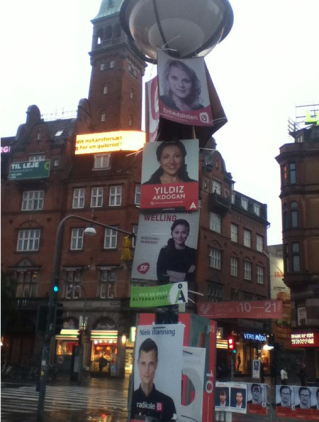
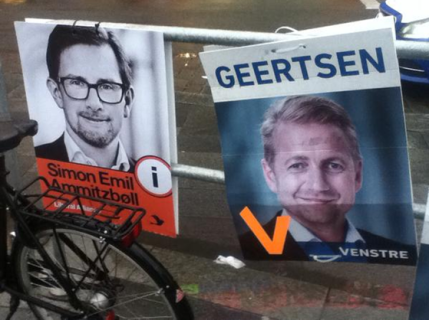
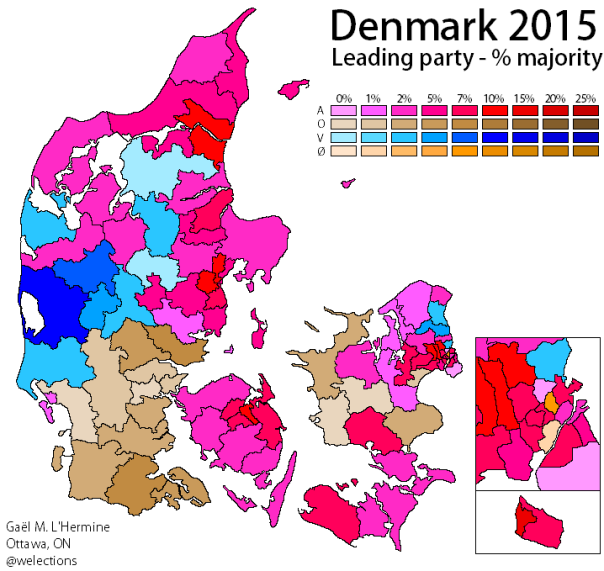
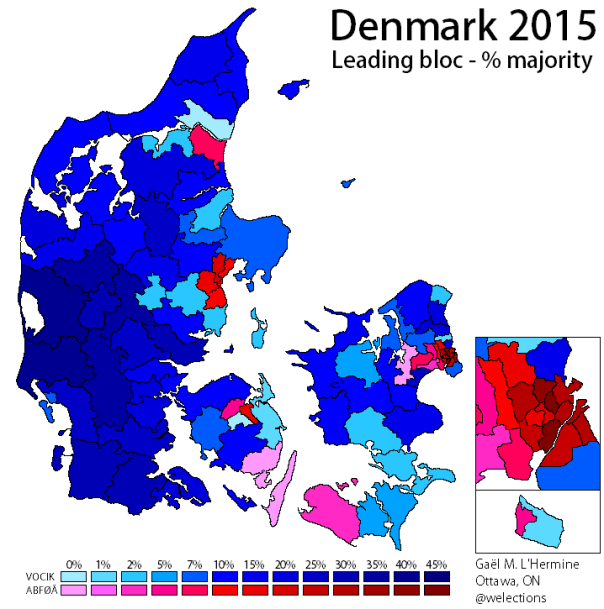
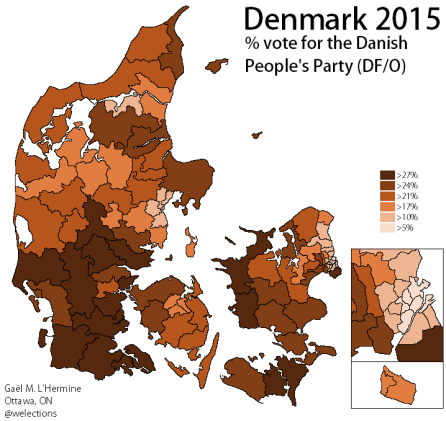

Leave a comment
Comments 0